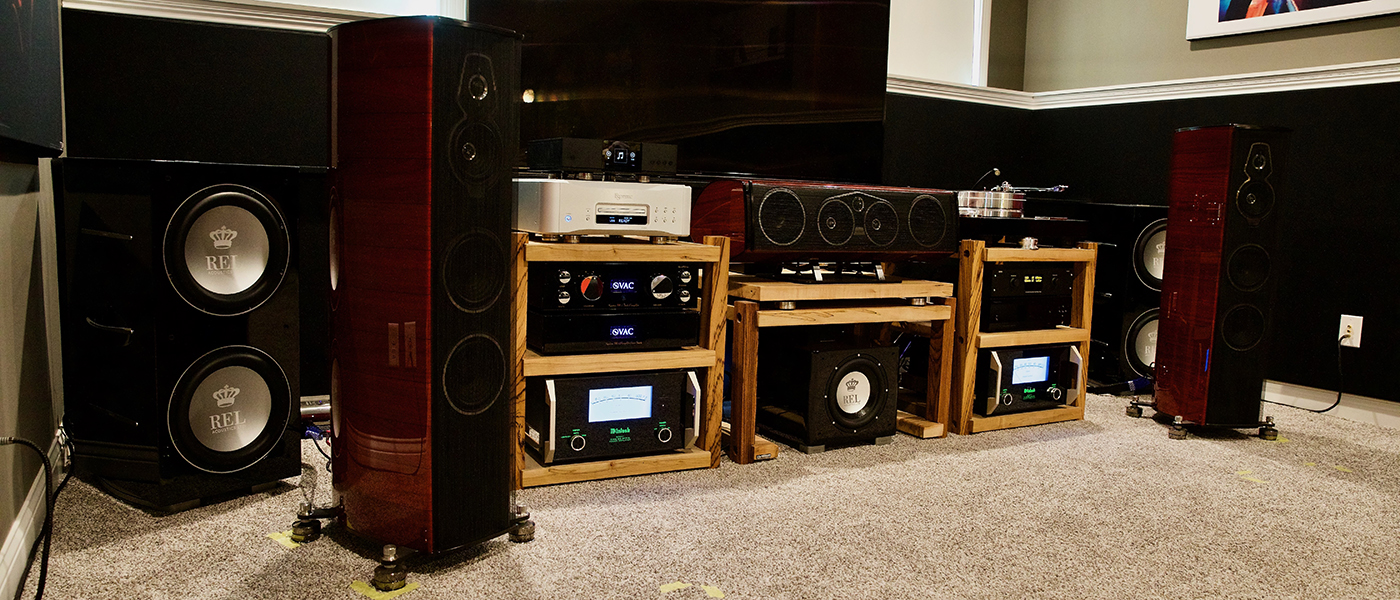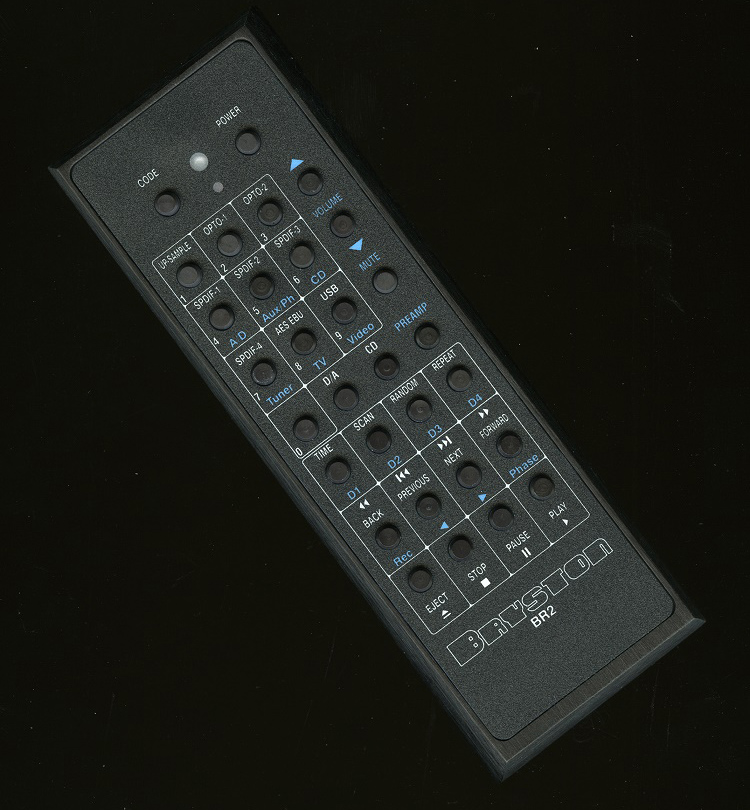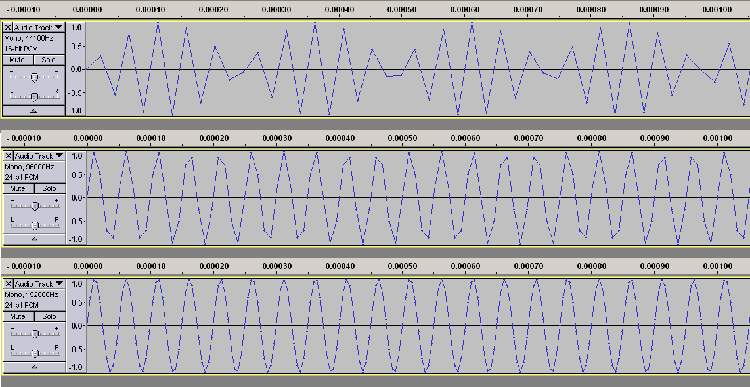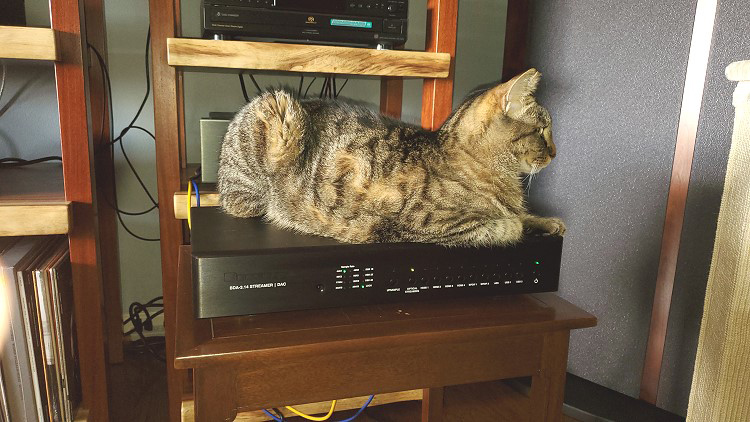
Streamers and streaming services have been here for a while but are really now taking hold of the music and movie delivery to consumers at home and anywhere they are located using their phones or tablets.
I put off setting up streaming because (1) I have all my music on hard drives connected to OPPO BDP-105 and UDP-205 players, using a phone and tablet app that shows me a directory of the music which I can play by simply tapping on an album or track; and (2) I am not very proficient with manipulating my wireless network.
This article is Part 2 of my project on showing our readers how easy it is to set up music streaming. The streamer reviewed here is the new Bryston BDA-3.14 Streaming DAC.
Bryston BDA-3.14 Streaming DAC
- Streamer and DAC in one chassis.
- 10 digital inputs including 4 HDMI, 2 USB, AES/EBU, S/PDIF RCA, S/PDIF BNC, and Toslink.
- Streaming up to 24/192 PCM.
- DSD can be played with the Streamer, converted to PCM.
- DAC is capable of 32/384 PCM and DSD-256 decoding.
- Pure Class A analog outputs.
- Selectable upsampling.
- Tidal, Qobuz, Roon, Internet Radio and more.
For the streaming service, I chose Qobuz because they offer streaming of high-resolution audio, up to 24/192, in lossless FLAC. It used to be $24.95/month, but recently has been reduced to $14.95/month, so I consider this a bargain for the quality that you get.
Here are photos of the Bryston BDA-3.14 Streaming DAC. You can click on them to see larger versions. It will decode up to 24/192 PCM, and it has numerous inputs so you can use the DAC to decode multiple sources besides streamed audio, such as USB digital output from your computer.
Analog outputs include both RCA and XLR. I used the XLR outputs.
A remote control is included, the BR2. A different remote will be included later. Click on the photo to see a larger version.
STREAMING FILE FORMATS:
AIFF, ALAC, APE, DIFF, DSF, FLAC, OGG, WAV, WV, AAC, MP3, MQA, and WMA
SAMPLING RATES:
Up to 32/384 PCM, DSD 256
FREQUENCY RESPONSE:
20 Hz – 20 kHz ± 0.1 dB
THD+N:
0.002%
NOISE:
RCA: -134 dB
XLR: -140 dB
INTERFACE:
BRYSTON WEBSITE
ACCESSIBLE FROM COMPUTER, SMARTPHONE, or TABLET
AUDIO OUTPUTS:
RCA COAXIAL, XLR BALANCED
DIMENSIONS:
17 or 19 W x 3.4 H x 12 D
WEIGHT:
8.5 lbs (4 kg)
MSRP:
$4,195
Company:
SECRETS Tags:
Bryston, Streamer, Streaming DAC, Qobuz, DAC Review 2020
The photograph of the Bryston BDA-3.14 Streaming DAC at the beginning of this review shows my cat sitting on top. That is because it is warm, due to the Pure Class A bias of the analog output stage.
Associated equipment included a Balanced Audio Technology VK-5i Pure Class A Triode (Tube) Stereo Preamplifier (Fully Balanced), Balanced Audio Technology VK-500 Solid State Stereo Power Amplifier (Fully Balanced) (250 Watts per Channel), and Magnepan 20.7 Planar Magnetic Full-Range Speakers. My cables were by Wireworld and Mogami.
Most consumers will probably use a hard-wired connection to their Wi-Fi router, but if you need to use wireless, you can purchase a dongle that will be plugged into one of the USB jacks on the rear panel.
In either case, the first thing to do (after powering-on your BDA-3.14) is going to the Bryston website at my.bryston.com. Although you can use your computer to do this, you can also use your cell phone or tablet. Eventually, you will probably be using the phone or tablet to operate the BDA-3.14 because it is so convenient. I used an iPad.
You will go through a series of steps, one of which assigns the BDA-3.14 as a hot spot and allows your phone or tablet to communicate directly with the BDA-3.14. You will need to select the Bryston hot-spot to do this and type in your Wi-Fi network password.
Secrets Sponsor
After this procedure, you will select the router for your Wi-Fi network, as the hot-spot is no longer needed for setup.
When you are finished with this procedure, going to my.bryston.com will take you to a page where your BDA-3.14 is available for you to select.
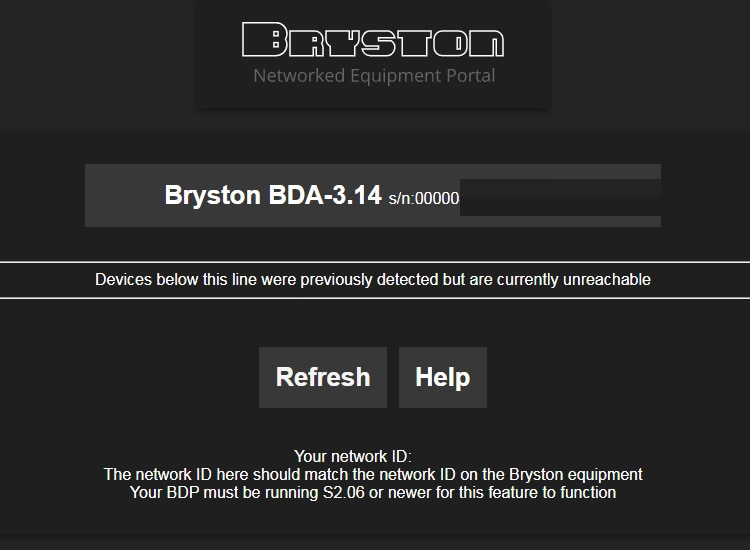
That takes you to the “Dashboard”, where you then can select the “Media Player” as shown below. Select Qobuz, assuming you have Qobuz. Then select the little gear on the left-hand side about 1/3 from the top.

That takes you to the Qobuz settings.
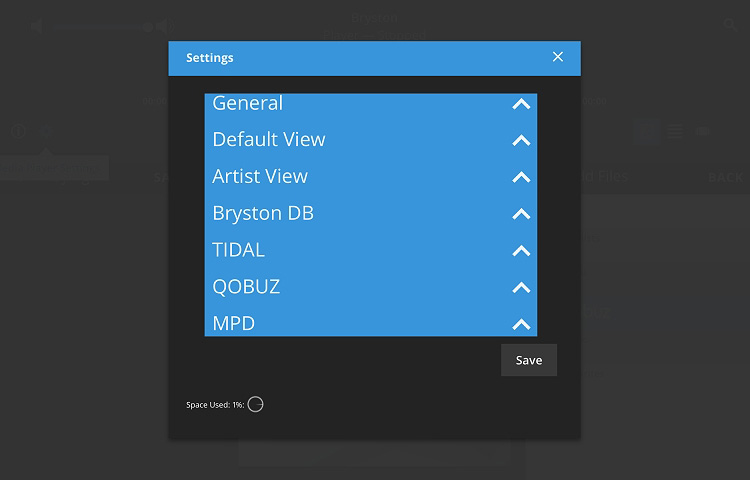
Selecting Qobuz shows you the menu below. I have the Studio plan, so I selected that option. If you have one of the other plans, such as 16-bit Lossless, you would select that one.
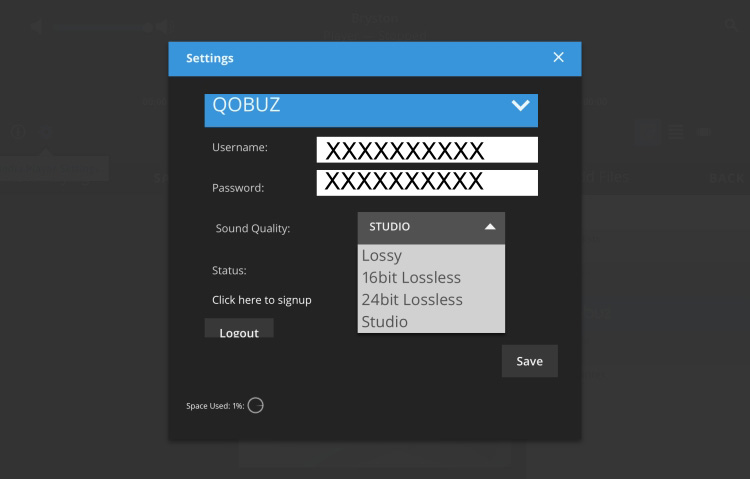
After that, go back to the Media Player. You can select your Favorites (Qobuz) folder or use the Search function in the top right corner to look for such things as Baroque Classical, Jazz, etc., or even a specific album. I selected Favorites (you can select albums to be added to the Favorites folder by accessing Qobuz from your computer or select them to be added from your phone or tablet using my.bryston.com.
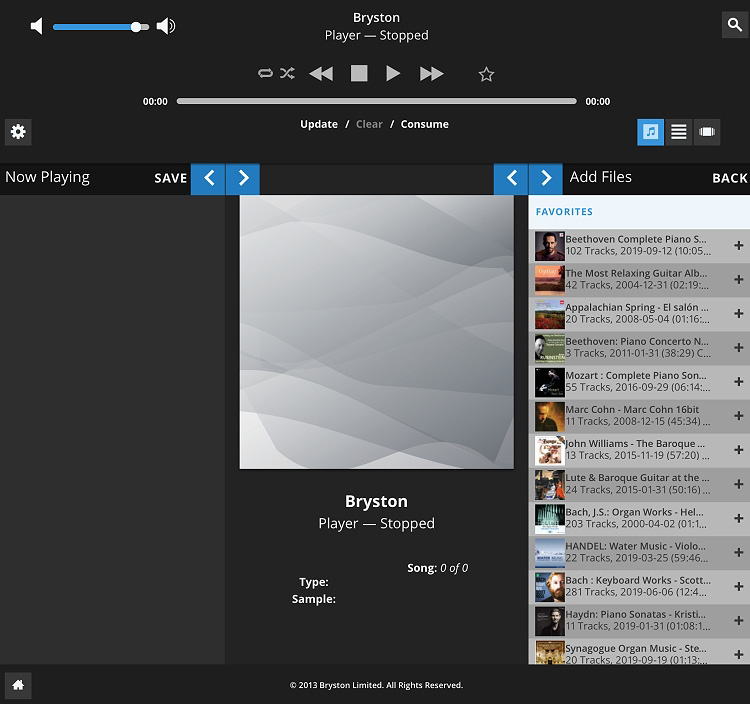
Enlarging the part of the screen on a phone or tablet (spreading your fingers on the surface of the screen of the phone or tablet) shows you the Favorites albums up close.
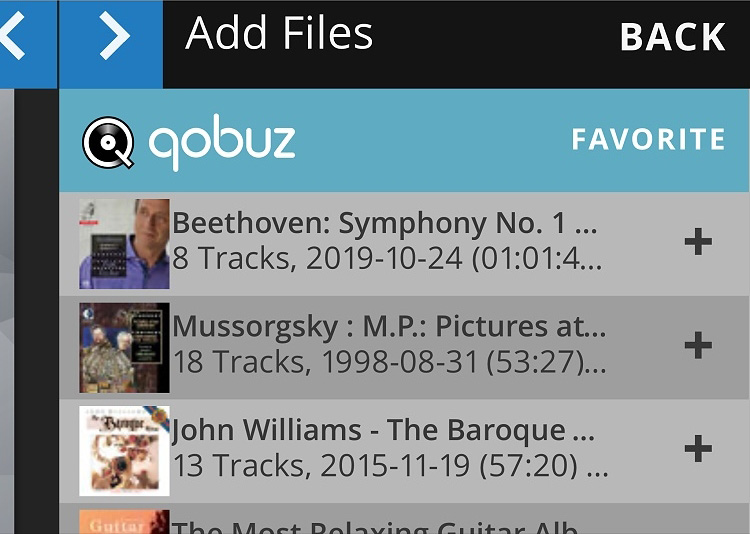
If you want to play the entire album, click on the + at the right-hand side of the selected album. If you want to just play a few tracks from an album, click on the album cover art at the left. I chose the Beethoven Symphony No.1 album and clicked on the +.
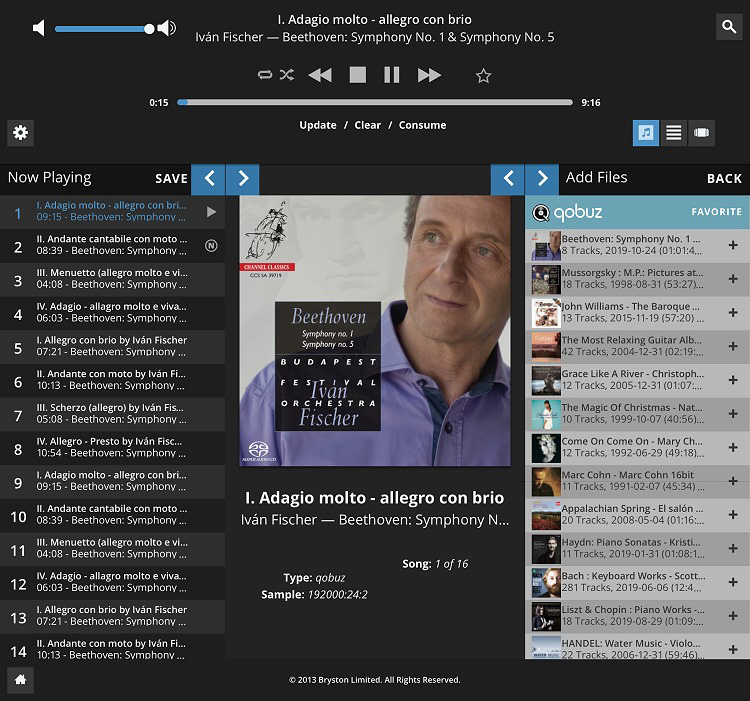
All the tracks of the album are now shown on the left. To start the album playing, you click on the first track. It begins to play, showing the track time at the top, center. You can adjust the volume at the top left by tapping on the speaker icon on the right-hand side to increase volume and the left-hand side to decrease it. What I did was to adjust the volume control on my preamplifier to be about as high as I would ever want it and the volume control on the iPad to a mid-level, begin playing the music and then turn the volume on the iPad up or down from there. For this album, I adjusted it all the way up.
The bit depth and sampling frequency are shown beneath the track title, underneath the album cover art. In this case, it is 192 kHz, 24 bit which is high resolution.
The sound of the Bryston BDA-3.14 was fantastic. Excellent clarity, clean, and dynamic. High-resolution adds detail and dynamics. This is a controversial subject, and some feel that music at 44.1/16 cannot be distinguished from 48/24 or higher. I won’t get into that argument here, but just say that I prefer high resolution because I believe that it will make a difference.
Next, I chose a Bach Organ album, Back to Bach, Famous Organ Works. This particular album was 88/24 which shows off the dynamics of high resolution. It thundered. I am very pleased with the quality of Qobuz streaming. The streamed music sounds every bit as good as music stored on a hard drive. I used the combination of the hard drive and the BDA-3.14 as music sources for this review, and I could not tell the difference. This tells me at least two things: (1) There is no loss in quality of the music that Qobuz serves; and (2) the Bryston BDA-3.14 DAC re-clocks the bitstream beautifully.
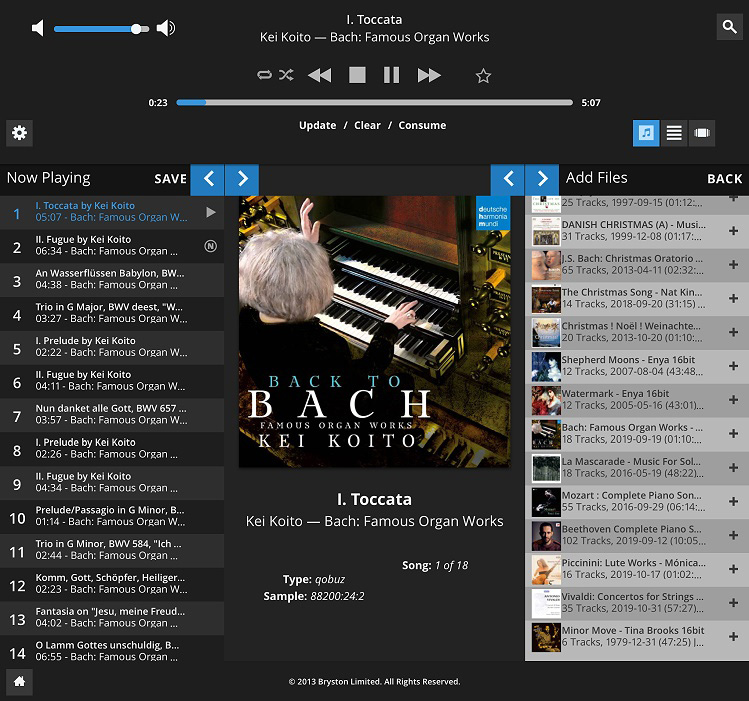
44.1 albums sound terrific as well. Take, for example, this one: Boss Tenor – Gene Ammons. Gene Ammons is my favorite jazz sax tenor. I have several of his albums on vinyl, and I added them to my Favorites folder. This particular one is 44.1/24 instead of 44.1/16, meaning it is 24 bit instead of the usual 16 bit. This is a good idea because, as you will see below, 24-bit sampling gives you a much better dynamic range. The original analog master tapes were used to create this 44.1/24 digital version.
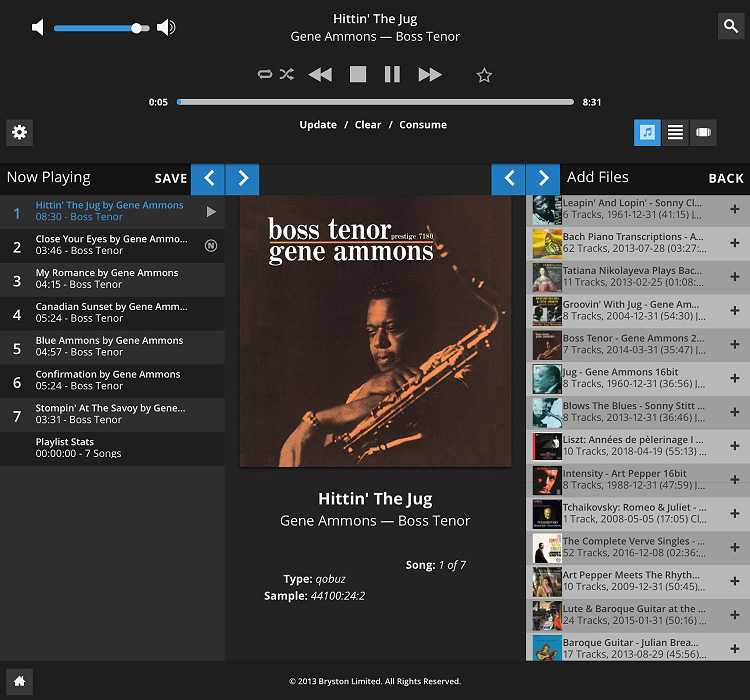
Comparing vinyl to digital is another contentious area in the audio circles. Yes, vinyl adds some distortion, in particular, 2nd ordered harmonics. But I like the effect. I also enjoy digital music. I don’t necessarily prefer one over the other. I just like having the choice.
I input digital test signals to the SPDIF 1 (RCA) jack on the Bryston BDA-3.14 Streamer/DAC.
First, some test signals with 16/44.1 sampling.
At 1 kHz and 0 dB, output (XLR balanced) was 4 volts. Distortion was very low, at 0.002% THD+N.
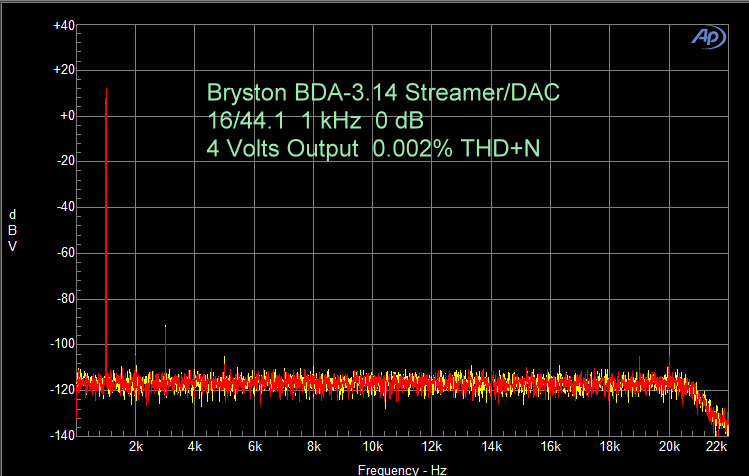
The remainder of the 16/44.1 tests, except for the Linearity, was done at – 5 dB.
Here is 1 kHz.
THD+N was 0.004%, which is higher than the result at 0 dB because the output was lower (2.3 volts), so the noise was a higher percentage of the total output. However, the harmonic peaks at 3 kHz and 5 kHz were lower.
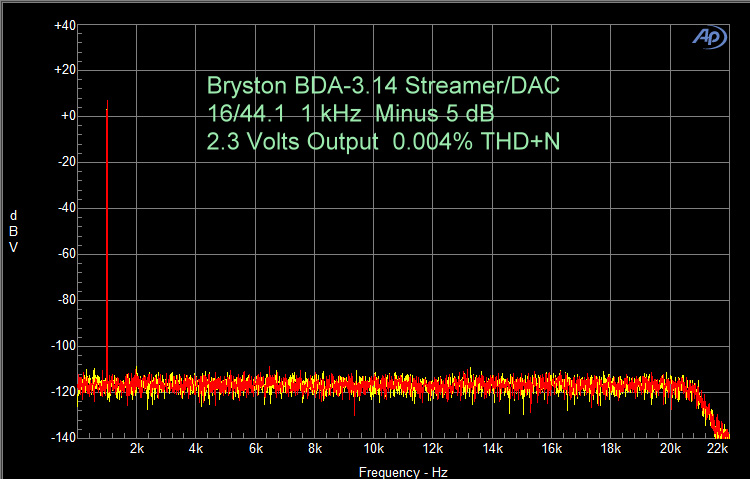
Using 19 kHz and 20 kHz sine waves, there was only a very small B-A peak at 1 kHz (-110 dB).
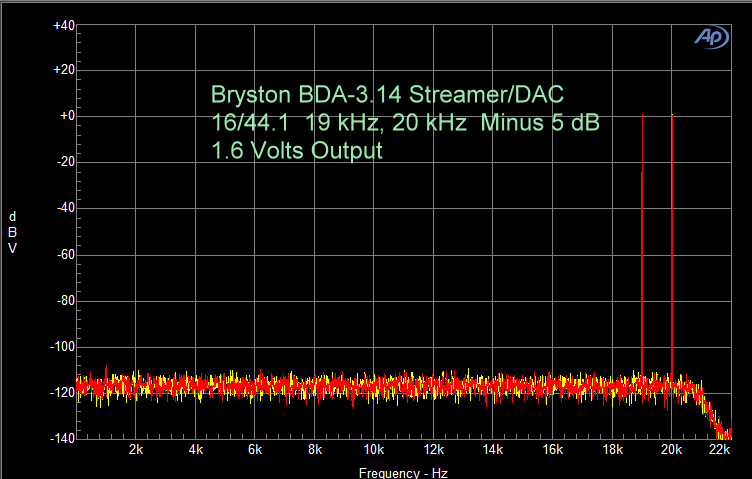
IMD was 0.005%.

Here is the 16/44.1 Frequency Response. I have set this up with a very shallow scale so that you can see there is a 0.08 dBV difference between the left (yellow) and right (red) channels. This is within an acceptable tolerance and is totally inaudible. Response is down 0.2 dBV at 20 kHz. Again, this is within an acceptable tolerance.
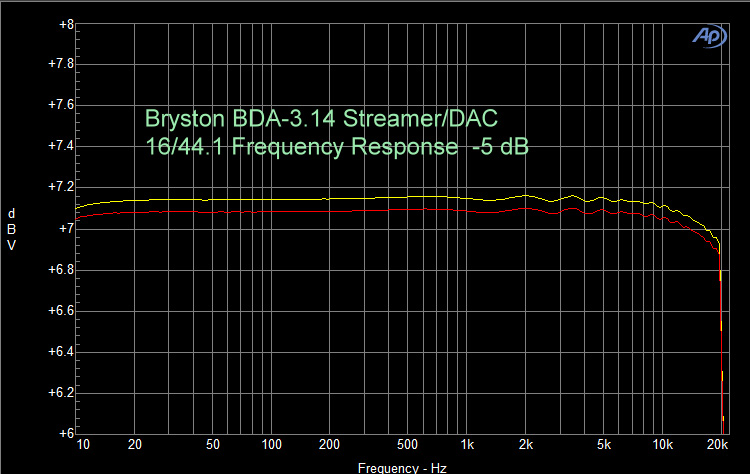
At 24/96 sampling, the results are shown below.
1 kHz, 0 dBV. The harmonics at 3 kHz and 5 kHz are about the same as with 16/44.1 sampling. This is probably due to the peaks being generated in the analog output stages rather than being generated by the digital-to-analog conversion process itself.
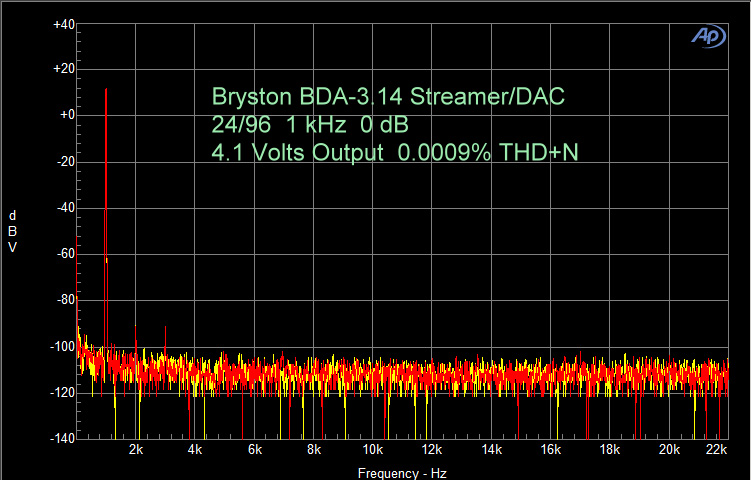
1 kHz, -5 dB. There is a 2nd harmonic at 2 kHz, but the peaks at 3 kHz and 5 kHz are gone. Overall THD+N is almost an order of magnitude lower than at 16/44.1 sampling.

!9 kHz and 20 kHz test signals resulted in a very small B-A peak at 1 kHz.

IMD was 0.001%.

The Frequency Response is shown below. Response is down 0.2 dBV at 20 kHz and down 1.1 dBV at 40 kHz.
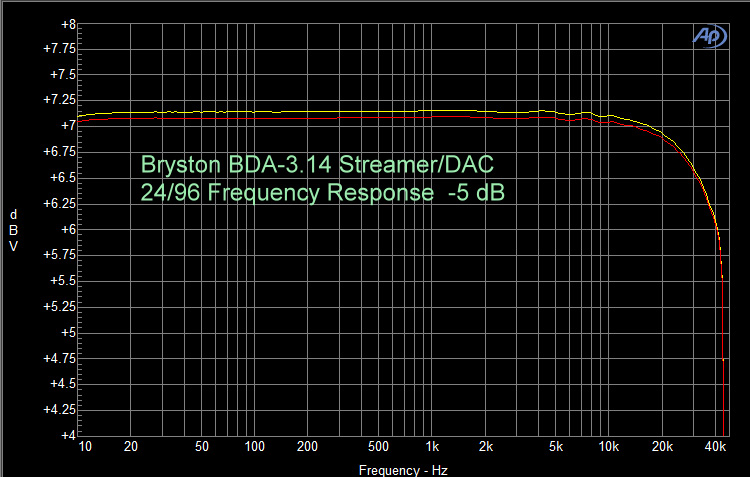
Now to 24/192. First, 1 kHz at 0 dB. It looks pretty much like the spectrum at 24/96. Distortion is at 0.0008%.
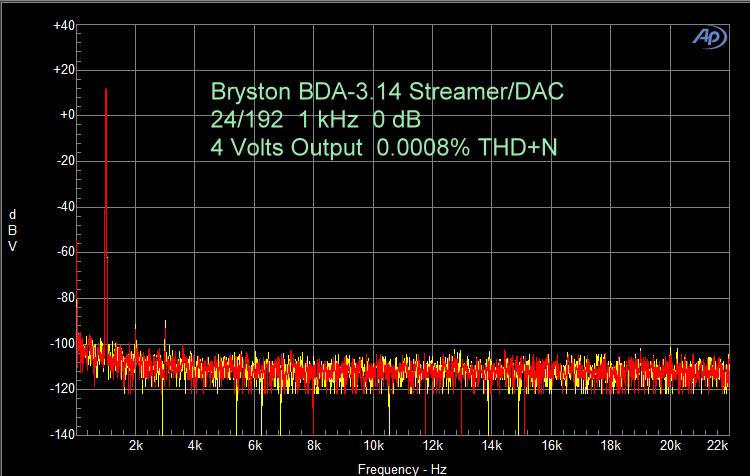
Reducing the signal to -5 dB results in lower distortion peaks.
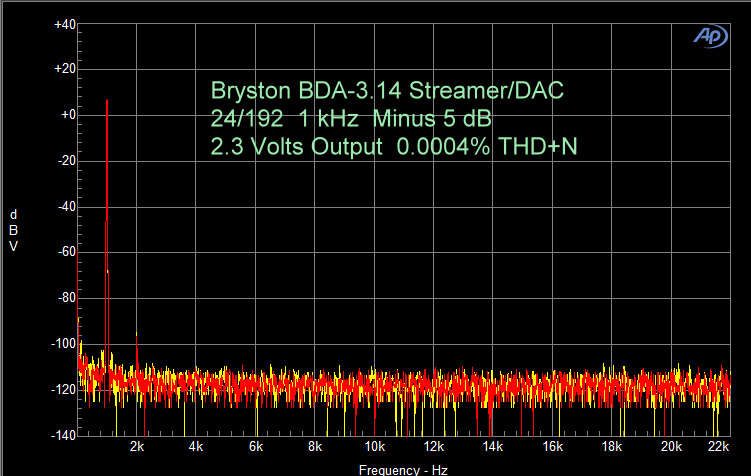
With 19 kHz and 20 kHz sine waves, the B-A peak at 1 kHz is very low.
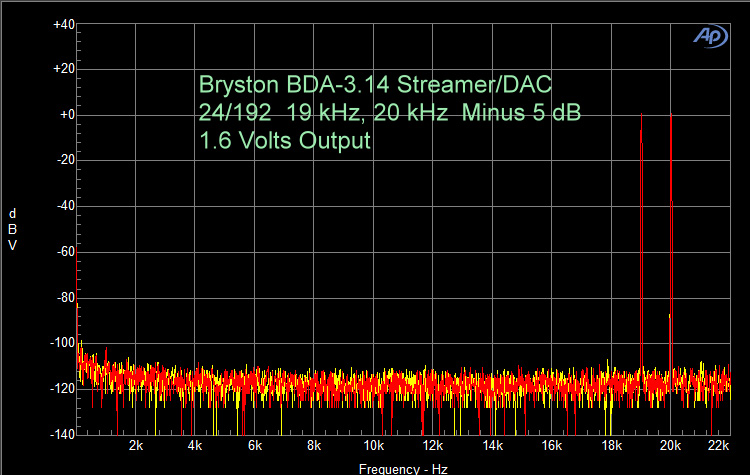
IMD is also very low.
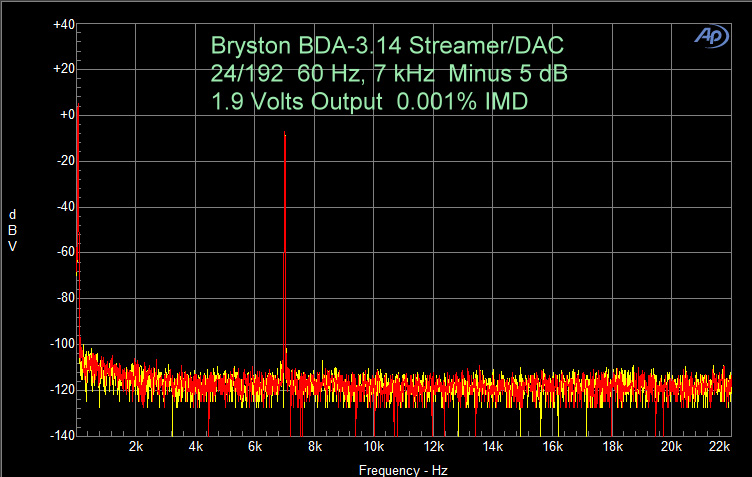
The frequency response at 24/192 sampling is down 1 dB at 40 kHz and down 2 dB at 75 kHz.
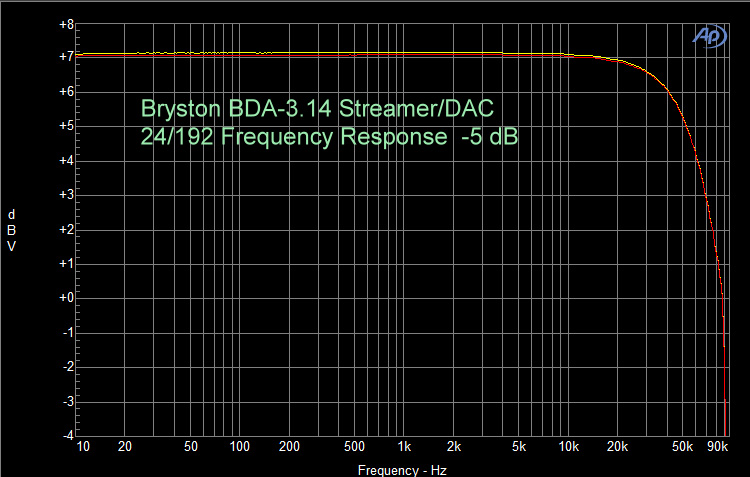
The effects of adding jitter are shown below. First, a 10 kHz sine wave with no jitter added.
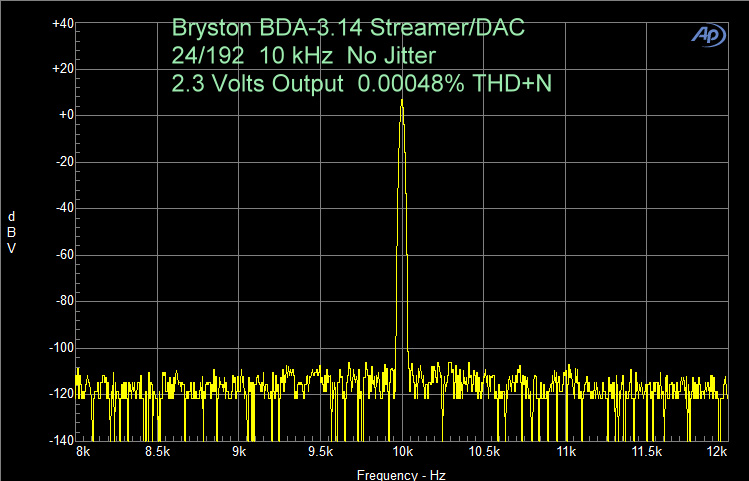
Now, the same test signal, but with 519 nanoseconds of sine wave jitter added. There are no side peaks, so even this large amount of jitter in the test signal is deleted by re-clocking.
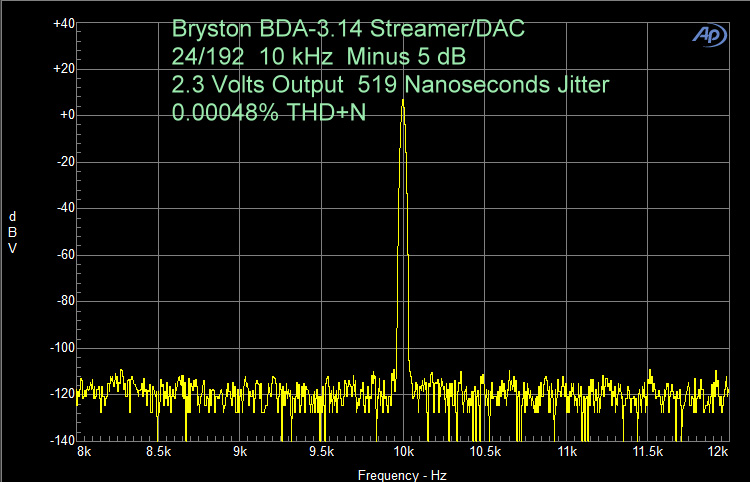
Here is what the side peaks would look like (below) if they were not compensated for. This particular test is from a different DAC (not Bryston). As in the figure above, 519 nanoseconds of sine wave jitter were added to the test signal. Side peaks are indicated by the arrows. So, the Bryston BDA-3.14 is very good at rejecting jitter.
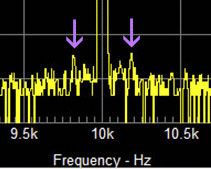
Linearity is shown in the next three figures. First, 16/44.1. Notice that the linearity starts flattening out at about -90 dB.
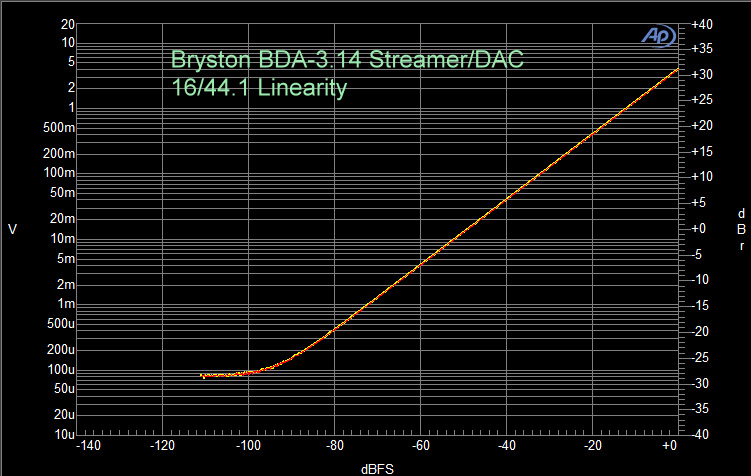
Here is the linearity curve for 24/96 sampling. The curve is linear to -110 dB. It is actually flat below that level, but the noise floor interrupts the visibility of the line.
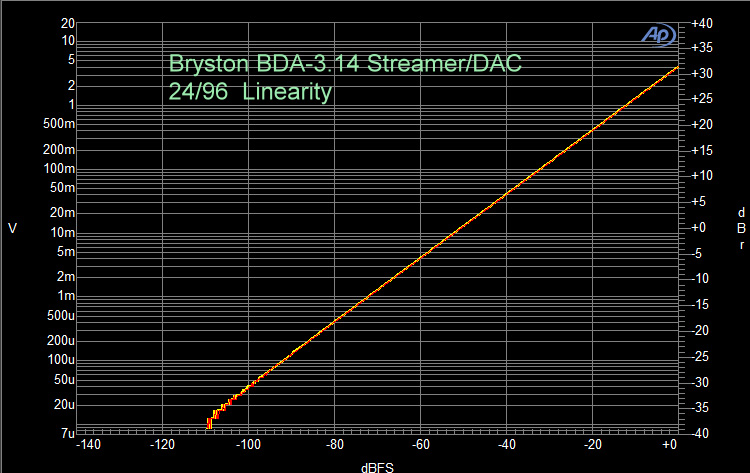
And, 24/192. The measurable linearity is down to -110 dB.
So, for 24-bit sampling, the dynamic range is increased by 20 dB. This is significant, perhaps more significant than any increased frequency response above 22 kHz that most of us (older individuals) cannot hear. Also, having a higher frequency as the boundary of the low-pass reconstruction filter (48 kHz for 24/96 sampling and 96 kHz for 24/192 sampling) gives less phase shift in the upper regions (near 20 kHz) of the defined audible band (20 Hz – 20 kHz).

Here is the Bryston BDA-3.14 noise floor, meaning the BDA-3.14 was powered on, but there was no test signal being sent to it. There are a few small, very low-level peaks, such as 60 Hz and 120 Hz, but that’s it. The -140 dB floor meets the specifications.
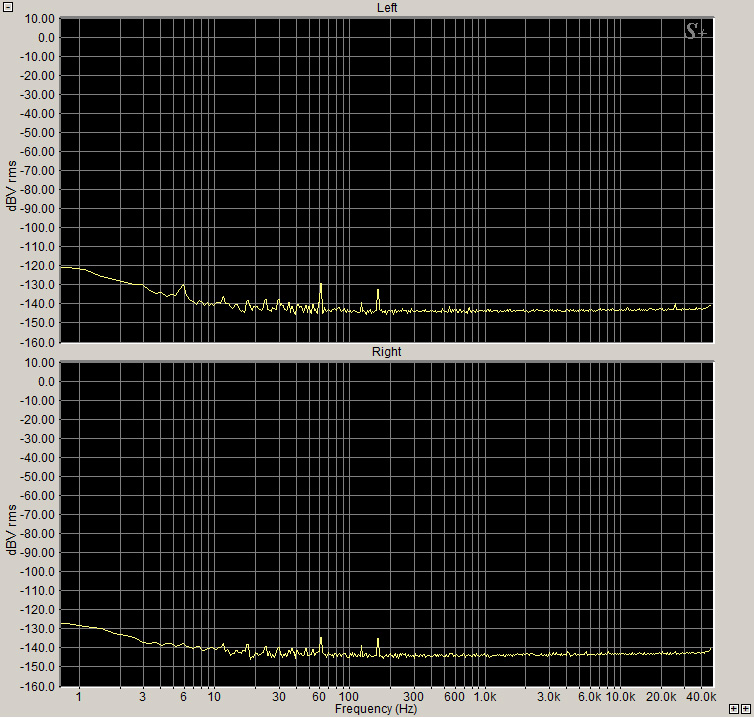
Below is something we started doing about 10 years ago. I measured a spectrum from music, averaged over a 10 second period. They were played from the Bryston BDA-3.14 and Qobuz music streaming service.
Secrets Sponsor
First, an album of organ music.

Stephan Lutermann “Synagogue Organ Music“
This album is 16/44.1. You can see that it has sound in the very low register, which is a reflection of the pedal tones.
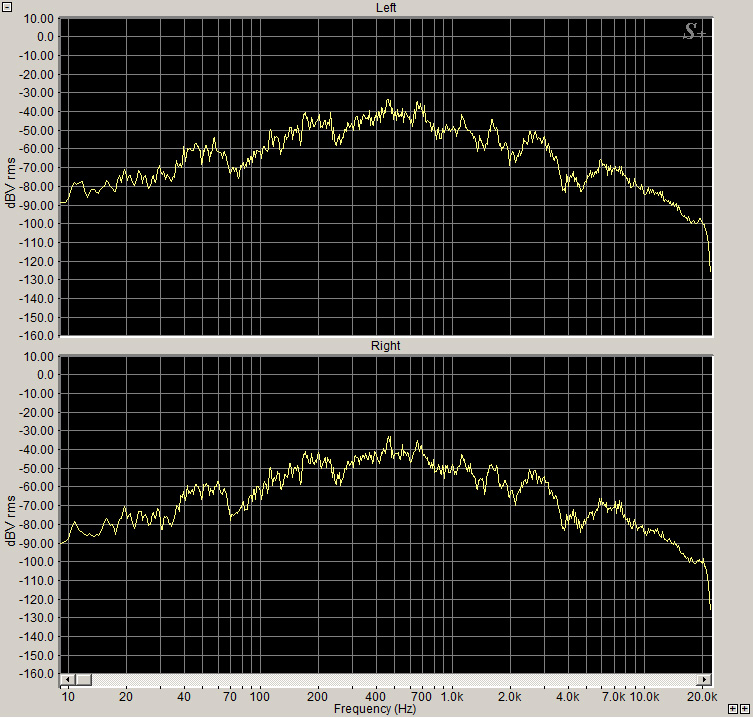
Next, a Bach keyboard works album, also in 16/44.1.

Scott Ross “Bach Keyboard Works“
The spectrum (an average of the first 10 seconds of the first track), below, shows a wide range of frequencies all the way out to 20 kHz. There are some very low frequencies as well.
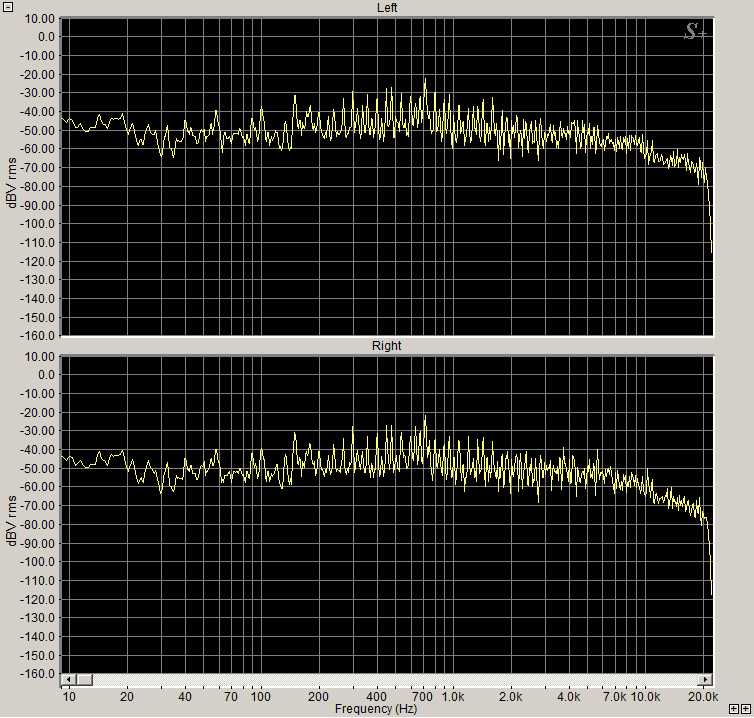
Lastly, this classic Eagles album. It is 16/44.1.

The Eagles “Their Greatest Hits“
Its range of frequencies is more limited than the previous two albums analyzed here.
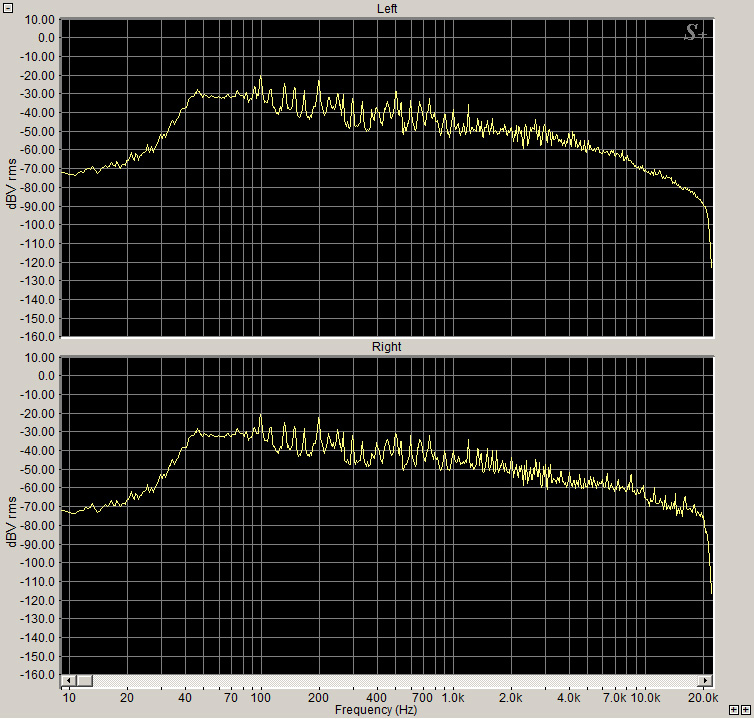
My experiences with high-resolution albums indicated that there were some additional frequencies in the 22 kHz – 25 kHz range. We are unlikely to be able to hear those high frequencies, but we should be able to detect the improved dynamic range with 24-bit sampling.
The advantage of very high sample rates is that the aliased frequencies (due to imperfect pre-sampling filtering and post-sampling reconstruction) are even higher, and far less likely to be picked up by a physical microphone or pass with any significant magnitude (above the thermal noise floor, etc.) through the anti-aliasing filters.
https://dsp.stackexchange.com/questions/59787/reconstruction-filter-how-does-it-actually-work
The sampling theorem describes why the input of an ADC requires a low-pass analog electronic filter, called the anti-aliasing filter: the sampled input signal must be bandlimited to prevent aliasing (here meaning waves of higher frequency being recorded as a lower frequency).
For the same reason, the output of a DAC requires a low-pass analog filter, called a reconstruction filter – because the output signal must be bandlimited, to prevent imaging (meaning Fourier coefficients being reconstructed as spurious high-frequency ‘mirrors’). This is an implementation of the Whittaker–Shannon interpolation formula.
Ideally, both filters should be brick wall filters, constant phase delay in the pass-band with constant flat frequency response, and zero response from the Nyquist frequency. This can be achieved by a filter with a ‘sinc‘ impulse response.
https://en.wikipedia.org/wiki/Reconstruction_filter
I tested some 10 kHz and 20 kHz sine waves that were recorded at several word lengths (16 bit or 24 bit) and sampling frequencies (44.1 kHz, 96 kHz, 192 kHz), analyzing them in a software sequencer.
Here are the results:
Below is a graph, showing the fine detail of digital recordings made at 16/44, 16/96, 16/192, 24/44, 24/96, and 24/192 using a 10 kHz sine wave. I wanted to vary only the word length for the test, to show that any differences would be a result of the sampling frequency; otherwise, there would be a compounding of variables. So, the sampling frequency graphs are shown both for 16-bit and 24-bit word lengths. From left to right, the plot spans 0.001 seconds, which is 1/1000th of a second. The dots on the graphs represent individual samples, so we are talking about really fine detail analysis here.
The dots represent finite voltage values that are fed in sequence as a stream to the DAC, which then produces a stair-stepped output, after which a low-pass reconstruction filter smooths out the signal. What I want you to notice is how jagged the lines are at standard Redbook CD 16/44. The DAC and reconstruction filter’s job is to make these jagged lines more sinusoidal so that it will be like the music that was recorded, which is also sinusoidal.
There are various ways of applying filters, and we won’t get into that here, but I was really surprised at how poorly the 16/44 digital stream is representing the original 10 kHz sine wave. Notice that even at 16/96, the lines are not all that smooth. But, at 16/192, the sine wave looks very good. If we were observing a 10 kHz sine wave coming off an LP and displayed on an oscilloscope, it would be essentially sinusoidal, not jagged (it would not be perfectly smooth of course, as there would be at least a little distortion in the signal being played).
Click on the images (graphs) to make them larger, then use the slider on the right-hand side to scroll the image, if necessary. Close the image by clicking on the X in the upper right-hand corner.
Here is the 10 kHz graph.
Here is a graph of a 20 kHz sine wave recorded at 16/44, 24/96, and 24/192. You can see that, even at 24/192, the wave form is not smooth, so a reconstruction filter still has to be applied. Is it any wonder that the arguments about Vinyl vs. CD go on and on?
https://hometheaterhifi.com/technical/technical-reviews/vinyl-vs-cd-running-commentary-parts-6-9/
- Easy to set up.
- Very High quality DAC.
- Lots of inputs.
- No improvemnets necessary
Streaming went from 7% of the US music market in 2010 to 80% in 2019.
I am convinced now that music streaming is the future for audio, not just for high-enders but for everyone. It is easy to set up, you have thousands of albums to choose from, and it is truly convenient – you can access your music from a phone or tablet while sitting anywhere in the room. You can also access it from another room, say your dining room while having dinner, playing music in the background.
The Bryston BDA-3.14 is an audiophile-grade piece of equipment. It is expensive, but these days, everything is expensive. You eventually will get a streamer if you don’t already have one. Why wait for the inevitable? Get one now and enjoy.


